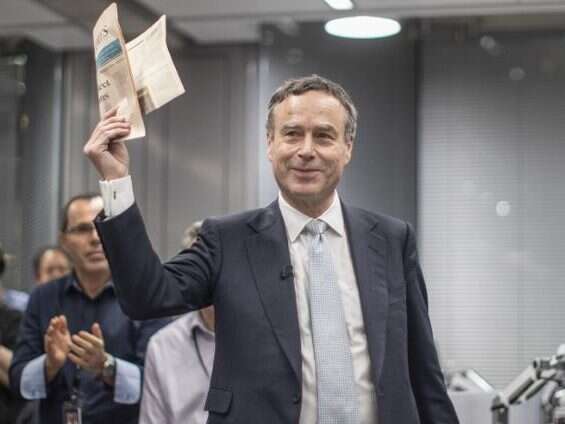
Former Financial Times editor Lionel Barber shares his leadership tips gleaned from 15 years at the FT in which he took it from loss-making print title to online subscription-fuelled powerhouse.
The year was 2005 and the Financial Times was in bad shape. We had lost £60m in the previous three years; advertising was down 50 per cent since the peak in 2000. Circulation was falling, particularly in our home market. Our journalism lacked consistency and quality. For a premium brand, that was potentially fatal.
This was the legacy I inherited when I was appointed editor of the FT. I was 50, a seasoned news editor and foreign correspondent but a relatively untested manager. Instinctively I grasped that my editorship would be judged by one single measure: digital transformation of the newsroom (and, implicitly, a successful transition to a new business model).
The question was how to bring about this fundamental shift from print to digital. Our business was still overwhelmingly print centric (420,000 global newspaper circulation versus 76,00 digital subscriptions). Transition to a “digital first” model would require wholesale changes in working practices – no easy task in a newsroom where the NUJ chapel’s default position was “Nyet”.
My first job was to restore confidence in our journalism. This was the sine qua non, and it required early, painful changes in the senior ranks. But I also needed to instill a sense of collective purpose, mindful of Benjamin Franklin’s comment ahead of the American Revolution: “We must, indeed, all hang together or, most assuredly, we shall all hang separately.”
My second task was to forge a partnership with my business counterparts. There was no question of blurring the lines on editorial coverage. But as editor, with a seat on the FT board, I was determined to help shape commercial strategy, especially the move to raise prices and an early, decisive shift towards a subscription model.
Naturally, my influence at board level depended to a degree on a willingness to support unpopular measures such as cost-cutting in order to meet profit targets. That might sound like the Faustian bargain; but, in truth, I never felt obliged to do anything which compromised the quality of our journalism. For his part, John Ridding, CEO, respected the separation of editorial from the business side when it came to coverage.
Effective communication was my starting-point as editor. I had to signal clearly what I was interested in: a focus on business and financial journalism with a global perspective. I also had to convey a sense of direction – “the vision thing” – with easily digestible messages. As Sir Howard Stringer, the first foreigner to run Sony Corporation and a fellow rugby fan in New York, told me: you may think people are listening. They are not. You have to say the same thing time and again. Finally the message might sink in.”
In the early days, I constantly invoked the need to shift to “digital first” with all the disruption that entailed. I banned the description of the FT as a newspaper. We were now a “news organisation”. Starting in 2013, our 125th anniversary year, I sent two strategy biannual letters to staff setting out clearly what I expected in terms of change, with specific milestones. Meeting those targets was central to my own credibility as a manager.
The third challenge was to admit, early, that our business model was broken. We had to build a subscriptions business, deal directly with customers (rather than being disaggregated via Factiva, Lexisnexis and others) and raise prices. That was a key message inside and outside the FT: readers had to understand we were not competing in the same bracket as other broadsheets. Journalists had to grasp that a higher priced product demanded even higher quality editorial.
One of the most important requirements for any editor is to recruit and retain talent. Lucy Kellaway once reprimanded me for using the word on the grounds that the FT was not a football team, but bringing in fresh blood is vital. It keeps people on their toes and avoids the culture becoming too inbred. Sir Alex Ferguson, whom I interviewed twice as editor, was a hero in this respect: his unparalleled winning streak as manager of Manchester United was based partly on force of personality but also an acute sense of timing when it came to rotating his top team. The same applies to newsrooms.
The step-by-step evolution of the digital newsroom, brilliantly led over a decade by Robert Shrimsley, unfolded without industrial disruption and under tight budgets.
Unlike some rivals, we did not neglect the newspaper in favour of digital. Print was still an important source of advertising revenue. Our strategy was to sharply reduce the number of print editions, introduce templated design for newspaper pages and produce the most efficient paper possible, with plenty of pre-planning and commissioning of stories. At the same time, we consciously “inverted” the production process in favour of web-based journalism. In one year, alone more than 200 job roles changed.
In truth, the shift to “digital first” took almost a decade. Looking back, I wonder if we could have moved further, faster. Our approach was often incremental; but a Mao-style revolution would have been too disruptive. We needed a degree of continuity while covering epoch-making stories like the global financial crisis, Brexit and the smartphone revolution.
That said, we were too slow to spot the potential for data journalism – an omission rectified in 2015 with the appointment of Alan Smith from the Office of National Statistics. And, even bearing in mind constraints on resources, we might have built more effectively on the digital innovation spawned by our ground-breaking financial blog, FT Alphaville launched in 2006.
Overall, however, the FT’s strategy has proved stunningly successful. By April 2019, we had passed 1m paying readers worldwide, more than doubling the readership compared to 2005. Under Nikkei, the giant publishing house in Japan which acquired the FT in 2015, the FT has become a genuine global media brand, a beacon of authority in a bleak media landscape. This is a source of personal pride, but also a tribute to FT journalists who kept the faith during turbulent times.
Lionel Barber, editor of the Financial Times 2005-20, is author of The Powerful and the Damned, private diaries in turbulent times. WH Allen: £25.
Email pged@pressgazette.co.uk to point out mistakes, provide story tips or send in a letter for publication on our "Letters Page" blog






